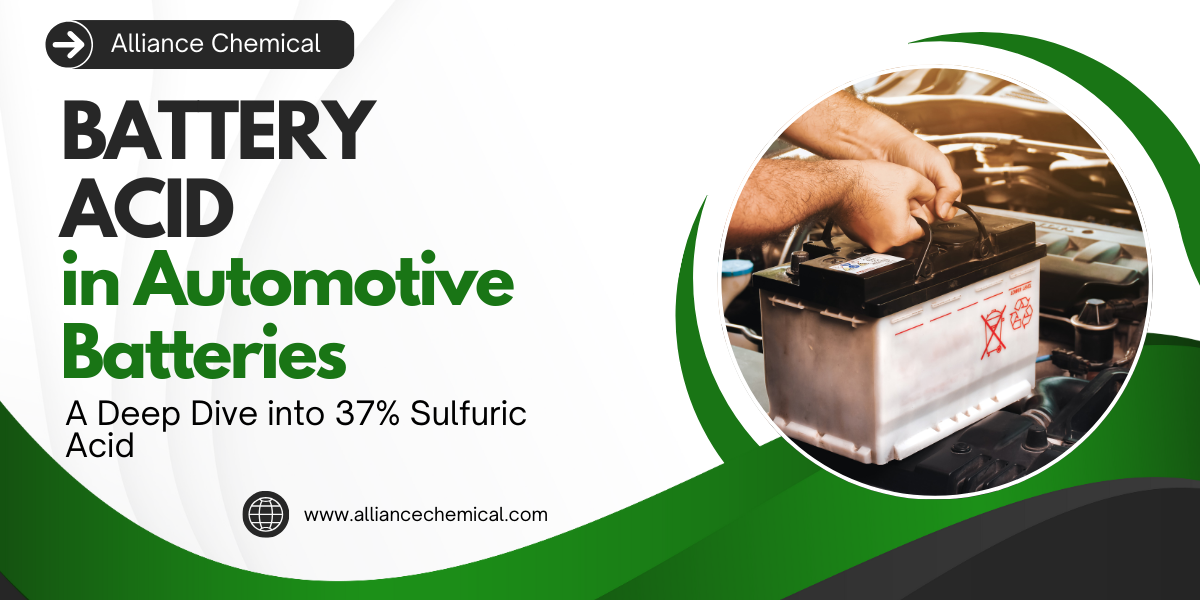
Battery Acid in Automotive Batteries: A Deep Dive into 37% Sulfuric Acid
What you will learn
📋 What You'll Learn
This guide walks you through battery acid in automotive batteries: a deep dive into 37% sulfuric acid with detailed instructions.
For over 150 years, the lead-acid battery has been the unsung hero of the automotive world, a steadfast power source that brings engines to life. At the very core of this enduring technology is its electrolyte: a precise solution of Sulfuric Acid in water, commonly known as battery acid. This definitive technical guide explores the intricate electrochemistry of the lead-acid battery, explains why a 37% concentration of Sulfuric Acid is the industry standard, details the critical importance of electrolyte purity, and provides the essential safety protocols for handling this powerful chemical.
The Electrochemistry of a Lead-Acid Battery
A conventional automotive battery is a marvel of applied chemistry, containing multiple cells where a reversible electrochemical reaction stores and releases energy. Each cell contains two sets of plates immersed in the electrolyte solution.
- Positive Plates: A grid of lead alloy coated with lead dioxide (PbO₂).
- Negative Plates: A grid of lead alloy filled with spongy, porous lead (Pb).
- Electrolyte: A solution of approximately 37% Sulfuric Acid (H₂SO₄) and 63% water.
The Discharge Cycle (Providing Power)
When you start your car, a chemical reaction begins. The sulfuric acid acts as the medium, and the sulfate ions (SO₄²⁻) actively participate in the reaction. At both plates, the lead and lead dioxide react with the sulfate to form lead sulfate (PbSO₄), and water is produced. This process releases a flow of electrons, creating the powerful electric current needed to turn the starter motor.
The Charging Cycle (Restoring Power)
When the car's alternator is running, it forces current back into the battery, reversing the reaction. The lead sulfate on the plates is converted back into lead and lead dioxide, and the water is consumed, returning sulfate ions to the electrolyte. This restores the battery's potential energy.
The "Sweet Spot": Why 37% Concentration is the Standard
The 37% concentration of sulfuric acid is not an arbitrary number. It represents a carefully optimized balance point for maximizing battery performance and lifespan, corresponding to a specific gravity of approximately 1.280 at room temperature when fully charged.
The Science of Specific Gravity
During discharge, sulfate ions are removed from the electrolyte and water is produced, causing the specific gravity (density) of the solution to drop. During charging, the process reverses, and the specific gravity rises. This is why a technician can use a hydrometer to measure the specific gravity of the electrolyte in each cell and accurately determine the battery's state of charge.
- Too High a Concentration (>40%): While a more concentrated acid might seem more powerful, it would be extremely corrosive to the battery's internal lead plates and grids, drastically shortening its life. It would also increase the risk of thermal runaway.
- Too Low a Concentration (<30%): A weaker electrolyte has a much higher freezing point, making it vulnerable to freezing and cracking the battery case in cold climates. It also has lower conductivity, reducing the battery's ability to deliver the high current needed for engine cranking.
Therefore, the 37% solution provides the ideal compromise: maximum conductivity and energy density with a low freezing point and manageable corrosivity.
The Critical Importance of Electrolyte Purity
The performance and lifespan of a lead-acid battery are acutely sensitive to impurities in the electrolyte. Using anything other than high-purity, "Electrolyte Grade" sulfuric acid can lead to rapid and irreversible damage.
The Dangers of Contamination
Common contaminants and their effects include:
- Iron and other Metal Ions: These impurities act as catalysts that dramatically increase the rate of gassing (the breakdown of water into hydrogen and oxygen), especially during charging. This leads to excessive water loss and a potentially explosive buildup of hydrogen gas.
- Chlorides: These ions increase the corrosion of the positive plate grids, leading to premature failure.
- Organic Matter: Organic impurities can coat the plates, interfering with the chemical reaction and reducing the battery's capacity.
This is why only Electrolyte Grade is acceptable. A product like Alliance Chemical's 37% Sulfuric Acid, Electrolyte Grade is manufactured under strict quality controls to ensure it is free from these damaging contaminants, guaranteeing optimal performance and the longest possible battery service life.
Understanding Modern Lead-Acid Battery Types
| Battery Type | Electrolyte State | Key Features | Primary Application |
|---|---|---|---|
| Conventional Flooded | Liquid | Serviceable (caps can be opened), most affordable, requires periodic maintenance (topping off with distilled water). | Older vehicles, economy applications. |
| Enhanced Flooded (EFB) | Liquid | Designed for start-stop vehicle technology, improved cycle life and charge acceptance. Maintenance-free. | Entry-level start-stop vehicles. |
| Absorbent Glass Mat (AGM) | Absorbed in Fiberglass Mat | Spill-proof, vibration resistant, higher power output, completely maintenance-free. | High-end vehicles, vehicles with high electrical loads (ADAS, large infotainment). |
MANDATORY Safety Protocols for Handling Battery Acid
Sulfuric Acid is an extremely hazardous and highly corrosive chemical. It can cause severe chemical burns that can lead to permanent scarring, blindness, and respiratory damage. It must be handled with the highest level of care.
- Personal Protective Equipment (PPE) is NOT OPTIONAL: Always wear heavy-duty acid-resistant gloves, splash-proof safety goggles, and a full-face shield. An acid-resistant apron or suit is essential.
- Explosion Hazard: Charging batteries produce flammable hydrogen gas. Eliminate ALL sources of ignition—sparks, open flames, smoking—from the work area.
- Ventilation is Critical: Always work in a very well-ventilated area to prevent the buildup of hazardous fumes and hydrogen gas.
- Handling and Dilution: When preparing electrolyte, ALWAYS add acid slowly to water (specifically, distilled or deionized water), never the other way around, to prevent a violent, boiling eruption.
- Spill Response: Neutralize spills immediately with a base like sodium bicarbonate (baking soda) until fizzing stops, then clean up according to local regulations.







